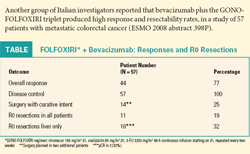New presurgical strategies render colon mets resectable
STOCKHOLM-Advances in surgical resection have removed the label of “death sentence” associated with colorectal metastases to the liver and lung. But that means oncologists must take on the task of refining strategies to increase resectability. At ESMO 2008, Alfredo Falcone, MD, of the University of Pisa and Instituto Toscano Tumori in Italy, discussed his approach for creating the ideal conditions for resectability.
ABSTRACT: The integration of cetuximab into a first-line chemotherapy doublet may be best for downsizing colorectal lung and liver metastases.
STOCKHOLM-Advances in surgical resection have removed the label of “death sentence” associated with colorectal metastases to the liver and lung. But that means oncologists must take on the task of refining strategies to increase resectability. At ESMO 2008, Alfredo Falcone, MD, of the University of Pisa and Instituto Toscano Tumori in Italy, discussed his approach for creating the ideal conditions for resectability.

For Dr. Falcone, the integration of cetuximab (Erbitux) to an eff ective first-line chemotherapy doublet may be the best means of downsizing these tumors. In large phase II and III trials, this regimen increased response rates by approximately 10% over chemotherapy alone and rendered an additional 3% to 5% of patients resectable, he said.
Dr. Falcone cited research, led by Renee Adam, MD, showing that 7% of patients receiving rescue cetuximab could undergo hepatic resection and 40% of this group were disease-free at 16 months (J Clin Oncol 25:4593-602, 2007).
Since there were successes even in the second- and third-line settings, Dr. Falcone advised reevaluating salvage patients for resectability. Selection of patients according to KRAS status should further improve upon these outcomes, he added.
The integration of bevacizumab (Avastin) plus a doublet as first-line treatment may increase resectability, but clear evidence from phase III studies is lacking, Dr. Falcone said.
“Bevacizumab has been shown to increase response rates by 10%, but this has had little to no effect on resectability,” he said. In studies in which bevacizumab was added to XELOX or FOLFOX-4, a trend toward higher resection rates has been observed, but the absolute increase was less than 2%.
“The most interesting finding, however, is that the two-year survival in patients resected after bevacizumab plus chemotherapy was 92%, vs 79% in the placebo arm in the NO16966 study (ASCO 2008 abstract 4022),” he said.
This finding is supported by the BEAT study, in which 6% of patients treated with chemotherapy plus bevacizumab were rendered resectable, and their two-year survival was 89%, compared with 47% for patients who could not be resected.
Dr. Falcone noted some concerns, however, about the safety of perioperative bevacizumab, specifically whether it may increase intraoperative bleeding, impair wound healing, or impede liver regeneration. But in the BEAT trial, serious wound healing complications were observed in only 1.3% of patients and bleeding in 0.4%.
The most recent studies, in fact, have validated the safety of bevacizumab, especially when it is discontinued five weeks before liver resection (J Clin Oncol 26:1830-1835, 2008).
Is the combination of a biologic and a triplet even more effective? “This is a promising approach but still experimental,” according to Dr. Falcone. In the Gruppo Oncologico del Nord Ovest (GONO) study, Dr. Falcone’s group observed significantly higher response rates (60% vs 34%), significantly greater resectability (15% vs 6%), significantly longer progression-free survival (9.9 vs 6.9 months), and significantly greater overall survival (23.6 vs 16.7 months) for patients receiving FOLFOXIRI, as compared with FOLFIRI. Other studies are validating the use of FOLFOXIRI plus bevacizumab to increase resectability (see Table).
Ongoing studies are also evaluating triplets plus cetuximab, with encouraging preliminary results, although diarrhea has been a concern, he added.
The Vantage Point on this article can be found here:
Coverting unresectable to resectable: Data still limited